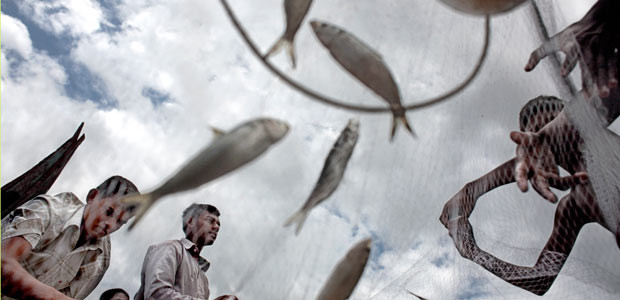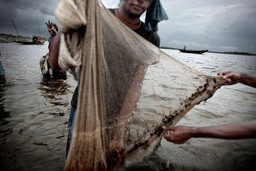Bangladesh: protecting the Hilsa from overfishing
Innovative ways to tackle overfishing problems and allow threatened hilsa fish stocks in Bangladesh to recover were devised by IIED and partners.

The Hilsa fish, called ‘Ilish’ in Bengali, is of national importance to Bangladesh. It’s one of the country’s main staple foods.
But increased demand for the fish, which is popular throughout South Asia, has led to pressure on the fish species. Not only is the Hilsa in trouble, but so are the three million fishermen, fisherwomen and fishery workers who directly or indirectly depend on the fish for their livelihood.
Bangladesh recognised that something needed to be done, and the government declared four areas as sanctuaries for the fish. In return for not fishing in these areas affected, fishing communities or households were rewarded with sacks of rice or provided with microcredit to start up small businesses to replace the lost income. This is an example of how economic incentives can be used to conserve fish resources.
However the scheme was not without its flaws. Knowledge gaps highlighted the need for further research into the effects the sanctuaries had on hilsa stocks, and also how the scheme reached and affected those people who depend on the fish for a living, particularly the poorest and most marginalised fishing communities.
What did IIED do?
This project filled this gap by redesigning the system that rewards people who help to protect it. Working in partnership with Bangladesh Centre for Advanced Studies and Bangladesh Agricultural University and in collaboration with the Department of Fisheries of the government of Bangladesh, IIED worked with affected communities and ecosystems to learn what is working and what is not, and found ways to improve it.
This project helped generate political will to create sustainable, bottom-up solutions that can both preserve hilsa and enhance livelihoods on a regional level. Researchers conducted a preliminary study of the government’s Hilsa Fisheries Management Action Plan (HFMAP), which compensated affected communities during an 11-day ban on fishing hilsa, and had been set up with little community input.
The researchers showed the government how it could improve its approach, making it more efficient, effective and sustainable. At a workshop organised by the partners, the government sat down as an equal partner with a diverse group of stakeholders. And as a
consequence of IIED and its partners establishing trust at an early stage, it was open to modifying policy to increase the social, economic and ecological sustainability of the fishery.
The project changed the government’s perceptions. As a result, it committed to increasing economic incentives to the wider community (increasing the coverage and extending the commitment period), as well as the amount of support to fisher men and women.
Lessening the hardship of complying with fishing bans encouraged the fishers to continue their cooperation to protect the hilsa voluntarily.
Key lessons
- By acknowledging the government’s good intentions and positive results, IIED and its partners established trust, opening the door to constructive suggestions and opportunities for more effective, equitable and sustainable approaches.
- Giving space for stakeholders to share their views built solidarity and partnership, strengthening collaboration. The participation of high-level government officials created buy-in to the process of change, and helped generate and maintain political will.
Additional resources
Power, profits and payments for ecosystem services in Hilsa fisheries in Bangladesh: a value chain analysis, Ina Porras, Essam Yassin Mohammed, Liaquat Ali, Md. Shahajat Alib, Md. Belayet Hossain (2017), article in the journal Marine Policy, Elsevier
Leave no one behind: power and profits in hilsa fishery in Bangladesh: a value chain analysis, Ina Porras, Essam Y Mohammed, Liaquat Ali, Md. Shahajat Ali, Md. Belayet Hossain (2016), IIED Working paper
News: UK dives in to save the hilsa (2013), Times of India
News: Project launched to make efforts more effective (2013), Daily Star, India
Partners
Bangladesh Centre for Advanced Studies (BCAS)
Bangaldesh Agricultural University
The Department of Fisheries of Bangladesh





